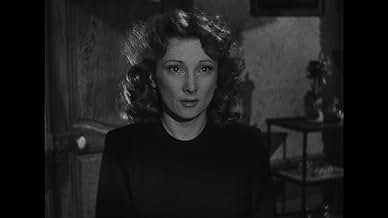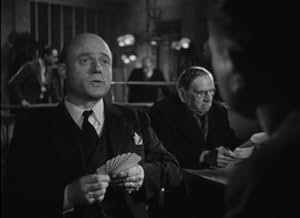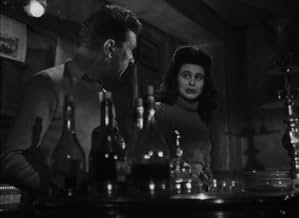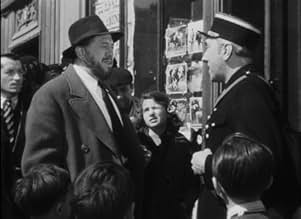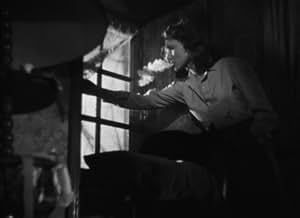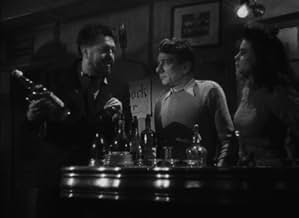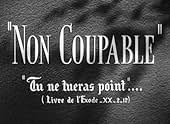अपनी भाषा में प्लॉट जोड़ेंAn alcoholic doctor accidentally kills someone and manages to make the death look like an accident. The episode triggers a sense of confidence and he resolves to correct the miseries of his ... सभी पढ़ेंAn alcoholic doctor accidentally kills someone and manages to make the death look like an accident. The episode triggers a sense of confidence and he resolves to correct the miseries of his life.An alcoholic doctor accidentally kills someone and manages to make the death look like an accident. The episode triggers a sense of confidence and he resolves to correct the miseries of his life.
Georges Bréhat
- Aubignac
- (as Georges Brehat)
Henri Charrett
- L'inspecteur Noël
- (as Charrett)
François Joux
- Le lieutenant Louvet
- (as Francois Joux)
Charles Vissières
- L'antiquaire
- (as Vissiere)
Emile Chopitel
- Tournier
- (as Chopitel)
Ariane Murator
- Madame Bastard, la mère de la petite malade
- (as Ariane Muratore)
Jean Sylvère
- Un ami du Docteur Ancelin
- (बिना क्रेडिट के)
फ़ीचर्ड समीक्षाएं
The description of a small town, a doctor whose life is mediocre, committed an deadly accident and begins to think about the perfect crime. The balack and white helps us to feel this dark story.
A very brillant performance of Michel Simon, one of the greatest actors of the beginning of the last century.
A very brillant performance of Michel Simon, one of the greatest actors of the beginning of the last century.
With "les inconnus dans la maison" (1942),Henry Decoin, one of the past masters of the French film noir,entered his more fruitful career ;but the trilogy he made before the end of WW2 (which encompass such works as "le bienfaiteur" and "l'homme de Londres ") was not entirely desesperate : some sunshine broke through .
It was no longer that way with "la fille du diable" (1945) ,the ending of which is one of the most pessimistic he ever conceived ;that may explain why "non coupable" has TWO endings :the producers suggested he film another sweetened conclusion* ,like Duvivier reluctantly did for his masterpiece "la belle équipe" (1936);now screened just after the film ,this new denouement brings nothing new and spoils the absolutely noir atmosphere of the movie: probably inspired by Fritz Lang's "woman in the window" (1944), it comes at the most awkward moment.
I suggest the 2021 (soon to be 2022) viewer leave after the director's cut (or turn off his TV set ) for ,as Decoin intended it , it is one of the apex of French film noir and begins where the precedent movie left ; the comparison is not irrelevant :both movies feature an outcast ,Isabelle ,'the Devil's daughter" in the 1945 effort Ancelin in "non coupable" ,a barfly doctor despised by the whole town ,including his colleague ,a smug elegant man who loves to bring him down ;in their scene together ,the words do not cut,they bite.
In both movies ,the press plays a prominent part :the cynical journalist in "non coupable" , Isabelle's cuttings in "la fille du diable".
I dare you to find ONE nice character in "non coupable" ; the crimes may be implausible (one of the main reproaches when the movie was released )but they inspire the director's extremism :based on a Marc -Gilbert Sauvageon 's screenplay ,it depicts the hypocrisy and the wickedness which linger on even when the customers have left the bistro ,leaving the human wreck with the owner and the waitress.
Michel Simon ,one of five greatest actors of the French cinema , gives a superlative performance ,in the part of a man rejected by a whole town (like in Duvivier's masterful "panique"(1945) ). Good support from Jany Holt as his wife and from Jean Wall as honorable doctor Dormont.
. *"les amants sont seuls au monde " (1947) has also another sweetened ending ;producers like happy ends best .
It was no longer that way with "la fille du diable" (1945) ,the ending of which is one of the most pessimistic he ever conceived ;that may explain why "non coupable" has TWO endings :the producers suggested he film another sweetened conclusion* ,like Duvivier reluctantly did for his masterpiece "la belle équipe" (1936);now screened just after the film ,this new denouement brings nothing new and spoils the absolutely noir atmosphere of the movie: probably inspired by Fritz Lang's "woman in the window" (1944), it comes at the most awkward moment.
I suggest the 2021 (soon to be 2022) viewer leave after the director's cut (or turn off his TV set ) for ,as Decoin intended it , it is one of the apex of French film noir and begins where the precedent movie left ; the comparison is not irrelevant :both movies feature an outcast ,Isabelle ,'the Devil's daughter" in the 1945 effort Ancelin in "non coupable" ,a barfly doctor despised by the whole town ,including his colleague ,a smug elegant man who loves to bring him down ;in their scene together ,the words do not cut,they bite.
In both movies ,the press plays a prominent part :the cynical journalist in "non coupable" , Isabelle's cuttings in "la fille du diable".
I dare you to find ONE nice character in "non coupable" ; the crimes may be implausible (one of the main reproaches when the movie was released )but they inspire the director's extremism :based on a Marc -Gilbert Sauvageon 's screenplay ,it depicts the hypocrisy and the wickedness which linger on even when the customers have left the bistro ,leaving the human wreck with the owner and the waitress.
Michel Simon ,one of five greatest actors of the French cinema , gives a superlative performance ,in the part of a man rejected by a whole town (like in Duvivier's masterful "panique"(1945) ). Good support from Jany Holt as his wife and from Jean Wall as honorable doctor Dormont.
. *"les amants sont seuls au monde " (1947) has also another sweetened ending ;producers like happy ends best .
Most people in the town, and all of its circle of important men, see Dr Ancelin as a failure like Charles Bovary: a hopeless, provincial drudge who works twice as hard to achieve half as much. But Ancelin has no Emma at his side (indeed, he terrifies his mistress Madeline, who is also cheating on him). He relies on alcohol and self-pity to get through the day as he sinks ever lower in the esteem of most of his neighbors, and perhaps himself. A fatal accident caused by the inebriated doctor provides the catalyst for the film's plot, in the course of which the good doctor tries to rehabilitate himself, at least in his own eyes, by a series of murders.
The view of life and human nature is about as bleak as it gets. Michel Simon embodies Ancelin's unpredictable violence and loathing, both for himself and just about everyone around him. His style of acting, looser and more uninhibited, contrasts with the classical style of the rest of the cast and makes the point even more forcefully.
Like Henri-Georges Clouzot, Henri Decoin directed films in France during the occupation (though, unlike Clouzot, he was not prohibited from directing after the war). Films like Clouzot's 'The Raven' ('Le corbeau') and Decoin's 'Non coupable' explore the realities of life under occupation decades before France would begin to deal with them publicly. Things that try to stay hidden have a terrible cost.
The view of life and human nature is about as bleak as it gets. Michel Simon embodies Ancelin's unpredictable violence and loathing, both for himself and just about everyone around him. His style of acting, looser and more uninhibited, contrasts with the classical style of the rest of the cast and makes the point even more forcefully.
Like Henri-Georges Clouzot, Henri Decoin directed films in France during the occupation (though, unlike Clouzot, he was not prohibited from directing after the war). Films like Clouzot's 'The Raven' ('Le corbeau') and Decoin's 'Non coupable' explore the realities of life under occupation decades before France would begin to deal with them publicly. Things that try to stay hidden have a terrible cost.
"Non Coupable" is ahead of its time in tone and themes: I got both Claude Chabrol and Twilight Zone vibes from it. What begins as a dark thriller has evolved by the end into a profoundly (and amusingly) ironic black comedy; the ending is just about perfect. Very strong performance by Michel Simon in the lead. Avoid plot spoilers. *** out of 4.
This must assuredly be the darkest of Henri Decoin's Film Noirs whilst its bleak and pessimistic tone is matched only by that of Duvivier's masterpiece 'Panique' from the same year.
Both films happen to star Michel Simon whose character in the earlier film is a tragic victim of circumstance whereas here he is the architect of his own downfall.
The screenplay by Marc-Gilbert Sauvajon is full of Gallic irony not least the film's title for although Simon's egomamiacal doctor longs to be found guilty of committing a series of seemingly perfect murders, his buffoonish exterior renders him above suspicion. He is a monstrous creature whose monstrosity is further enhanced by cameraman Jacques Lemare's low-angle shots. The final devastating dénouement represents the ultimate irony and is far more effective than the alternative upbeat ending that Decoin was obliged to shoot.
Excellent performances from Jean Wall as a rival doctor, the always-good-value Jean Debucourt as the investigating detective and Jany Holt as Simon's increasingly terrified mistress. As for Monsieur Simon one simply runs out of superlatives when describing this magnificent artiste whose portrayal here of a vainglorious but pitiable figure adds to his gallery of masterful characterisations.
Upon reading that a proposed remake to be directed by Christopher Gans and starring Albert Dupontel never came to fruition, this viewer could not help but heave a sigh of relief.
Both films happen to star Michel Simon whose character in the earlier film is a tragic victim of circumstance whereas here he is the architect of his own downfall.
The screenplay by Marc-Gilbert Sauvajon is full of Gallic irony not least the film's title for although Simon's egomamiacal doctor longs to be found guilty of committing a series of seemingly perfect murders, his buffoonish exterior renders him above suspicion. He is a monstrous creature whose monstrosity is further enhanced by cameraman Jacques Lemare's low-angle shots. The final devastating dénouement represents the ultimate irony and is far more effective than the alternative upbeat ending that Decoin was obliged to shoot.
Excellent performances from Jean Wall as a rival doctor, the always-good-value Jean Debucourt as the investigating detective and Jany Holt as Simon's increasingly terrified mistress. As for Monsieur Simon one simply runs out of superlatives when describing this magnificent artiste whose portrayal here of a vainglorious but pitiable figure adds to his gallery of masterful characterisations.
Upon reading that a proposed remake to be directed by Christopher Gans and starring Albert Dupontel never came to fruition, this viewer could not help but heave a sigh of relief.
क्या आपको पता है
- ट्रिवियाThe movie has an alternative ending, which is shown after the restored version of the film.
- गूफ़The crime takes place in a village of "Indre et Loire" (newspaper title). However, the big town around, twice quoted, is Chartres, i.e., in "Eure et Loire".
टॉप पसंद
रेटिंग देने के लिए साइन-इन करें और वैयक्तिकृत सुझावों के लिए वॉचलिस्ट करें
विवरण
- चलने की अवधि1 घंटा 35 मिनट
- रंग
- ध्वनि मिश्रण
- पक्ष अनुपात
- 1.37 : 1
इस पेज में योगदान दें
किसी बदलाव का सुझाव दें या अनुपलब्ध कॉन्टेंट जोड़ें


